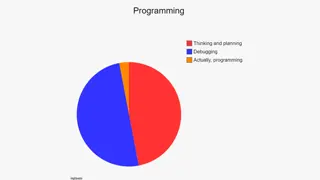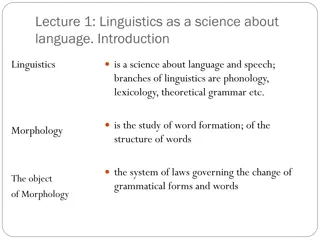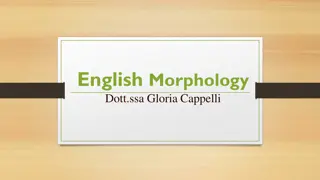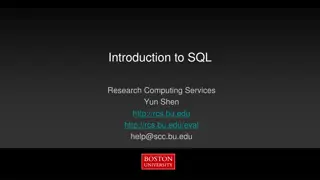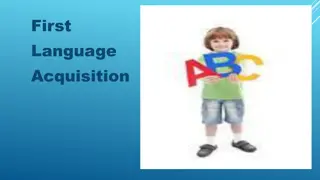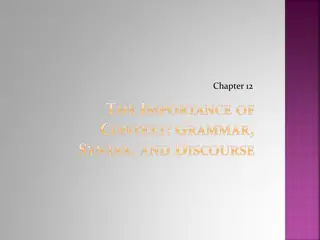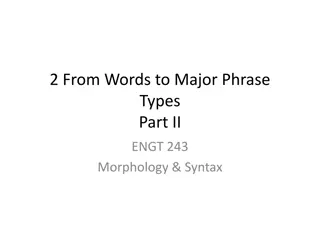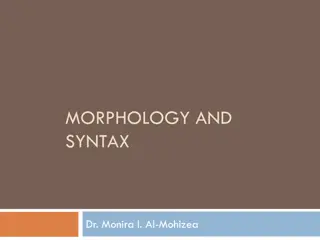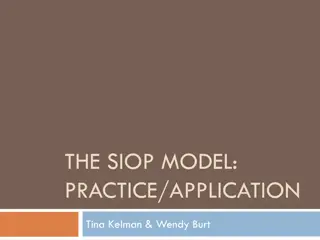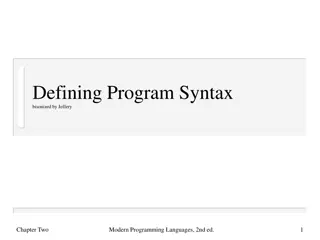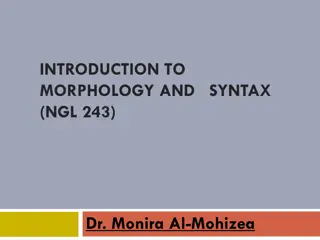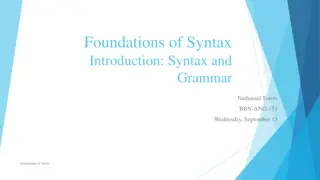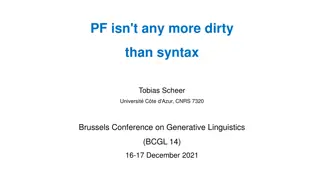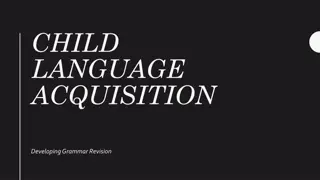Language Development in Children: Morphology and Syntax Acquisition
Children's language acquisition process involves developing morphology by adding inflectional morphemes to nouns and verbs, such as "-ing" and "-s" for plurals. Overgeneralization occurs as children apply rules, leading to expressions like "foots" and "mens". Additionally, irregular plurals and possessive forms are gradually incorporated. The development of syntax shows children using varied verb forms like "are" and irregular past-tense forms before mastering regular inflections. Syntax development reveals insights against the imitation theory in children's speech production.
Download Presentation

Please find below an Image/Link to download the presentation.
The content on the website is provided AS IS for your information and personal use only. It may not be sold, licensed, or shared on other websites without obtaining consent from the author.If you encounter any issues during the download, it is possible that the publisher has removed the file from their server.
You are allowed to download the files provided on this website for personal or commercial use, subject to the condition that they are used lawfully. All files are the property of their respective owners.
The content on the website is provided AS IS for your information and personal use only. It may not be sold, licensed, or shared on other websites without obtaining consent from the author.
E N D
Presentation Transcript
The acquisition Process child: My teacher holded the baby rabbits and we patted them. mother: Did you say your teacher held the baby rabbits? child: Yes. mother: What did you say she did? child: She holded the baby rabbits and we patted them. mother: Did you say she held them tightly? child: No, she holded them loosely
Developing morphology By the time a child is two-and-a-half years old, he or she is going beyond telegraphic speech forms and incorporating some of the inflectional morphemes that indicate the grammatical function of the nouns and verbs used. The first to appear is usually the -ing form in expressions such as cat sitting and mommy reading book
The next morphological development is typically the marking of regular plurals with the -s form, as in boys and cats. The acquisition of the plural marker is often accompanied by a process of overgeneralization. The child overgeneralizes the apparent rule of adding -s to formplurals and will talk about foots and mans. When the alternative pronunciation of the plural morpheme used in houses (i.e. ending in [- z]) comes into use, it too is given an overgeneralized application and forms such as boyses or footses can be heard
At the same time as this overgeneralization is taking place, some children also begin using irregular plurals such as men quite appropriately for a while, but then try out the general rule on the forms, producing expressions like some mens and two feets, or even two feetses. Not long after, the use of the possessive inflection - s occurs in expressions such as girl s dog and Mummy s book.
At about the same time, different forms of the verb to be, such as are and was, begin to be used. The appearance of forms such as was and, at about the same time, went and came should be noted. These are irregular past-tense forms that we would not expect to hear before the more regular forms. However, they do typically precede the appearance of the -ed inflection. Once the regular pasttense forms (walked, played) begin appearing in the child s speech, the irregular forms may disappear for a while, replaced by overgeneralized versions such as goed and comed.
Developing Syntax Similar evidence against imitation as the basis of the child s speech production has been found in studies of the syntactic structures used by young children. One child, specifically asked to repeat what she heard, would listen to an adult say forms such as the owl who eats candy runs fast and then repeat them in the form owl eat candy and he run fast. It is clear that the child understands what the adult is saying. She just has her own way of expressing it.
Forming Questions In forming questions, the child s first stage has two procedures. Simply add a Wh-form(Where,Who) tothe beginning of the expression or utter the expression with a rise in intonation towards the end, as in these examples: Where kitty? Doggie? Where horse go? Sit chair?
In the second stage, more complex expressions can be formed, but the rising intonation strategy continues to be used. It is noticeable that more Wh-forms come into use, as in these examples: What book name? You want eat? Why you smiling? See my doggie?
Forming Negatives In the case of negatives, stage 1 seems to involve a simple strategy of putting no or not at the beginning, as in these examples: no mitten not a teddy bear no fall no sit there In the second stage, the additional negative forms don t and can t appear, and with no and not, are increasingly used in front of the verb rather than at the beginning of the sentence, as in these examples: He no bite you I don t want it That not mommy You can t dance
Developing Semantics The anecdotes that parents retell about their child s early speech (to the intense embarrassment of the grown-up child) usually involve examples of the strange use of words. Having been warned that flies bring germs into the house, one child was asked what germs were and the answer was something the flies play with . It is not always possible to determine so precisely the meanings that children attach to the words they use.
It seems that during the holophrastic stage many children use their limited vocabulary to refer to a large number of unrelated objects. One child first used bow-wow to refer to a dog and then to a fur piece with glass eyes, a set of cufflinks and even a bath thermometer. The word bow-wow seemed to have a meaning like object with shiny bits . Other children often extend bow-wow to refer to cats, cows and horses
This process is called overextensionand the most common pattern is for the child to overextend the meaning of a word on the basis of similarities of shape, sound and size, and, to a lesser extent, movement and texture. Thus the word ball is extended to all kinds of round objects, including a lampshade, a doorknob and the moon.


